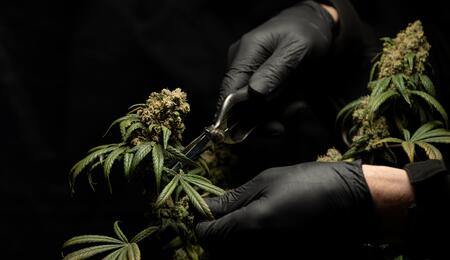Orange CBD, how to breed a champion

The delicious breakfast Purple Orange CBD was awarded the second prize in the recent Highlife Cup 2015 drug contest. Dinafem is working intensely to achieve a strain of excellent taste, with optimal THC and CBD ratios. We visited the installations of Dinafem, where we met the coordinator of breeders, Doctor Kush and the lab director, Doctor Ananda. Both were selecting specimens to be sent to the Expogrow Cup, Irún (Spain). While we were tasting a generous selection of samples, they told us the history of how Orange CBD was created.
Origin
Dinafem’s collaboration with their friends from the Humboldt Seeds Organization is well know. In particular, Dinafem contributes its breeding infrastructure, as well as its marketing and distribution network, whereas HSO sources the finest select strains from the USA. The genetics that was used as base for Orange CBD derives from one of the batches that HSO delivered to Dinafem.
More specifically it was a set of 25 regular strains. Based on the information given to Dinafem, this crossbreed was created in California from Sour Diesel and California Orange, a.k.a. Tangie. The original name under which the final strain was derived is Lemon Diesel. This particular taste, in turn, originates from the family of the famous New York City Diesel, a strain from which in 2004 a number of specimens with CBD were derived.
These in turn gave rise to a European CBD-rich branch. Although it bears New York in its name, it seems that California is the other place of origin of this NYCD. When they were working on Lemon Diesel, they discovered that CBD could also be found in this strain. Given their common origin, taste and CBD content, the Dinafem team maintain that the genetic bases of Lemon Diesel are similar to those of New York City Diesel.
From Lemon Diesel to Purple Orange CBD
Without knowing that Lemon Diesel contained CBD, Dinafem started to make a selection together with their friends and collaborators, for the large volume of genetics to be tasted. A breeder from a Cannabis Social Club (CSC) made the first selection and, since the beginning, focused much on Lemon Diesel, as he appreciated its citric taste and balanced effect. 300 seeds were germinated and a selection was made from a mother, with a marked taste of citric chocolate.
At the end of blooming, a slight hermaphroditic inflorescence appeared but no fertile pollen was generated to pollinate the plant. The CSC analysed all strains before handing them out to their members; when Lemon Diesel was tasted, an appreciable CBD content was discovered. The selection was then publicly presented to consumers, and it soon became the favourite strain of many members of the club and a part of the Management Board. When extracts were ultimately released, a well-defined taste had been achieved, with a significant terpene content on the completion of the process.
The CBD content of the strain was therefore known, after which the second selection was made. They started from 500 regular seeds of Lemon Diesel grown in a commercial substrate. During the selection, visible males and hermaphrodites were discarded and other factors were considers such as the plant’s evolution, vigour, size or output. At the end of the process, 60 females were selected, which were introduced into jars and labelled.
A first, extended tasting event was held at night with experts from Dinafem, HSO and the CSC who had made the first selection, during which they only considered the smell. At the first tasting round, they selected a number of prime samples. Then they repeated the tasting with another team and results were noted down. In a third tasting round, they considered the smell on pressing the bud.
Next, a further selection was made among the plants that were most frequently selected in each tasting round. Subsequently, a fourth ‘playoff’ selection was organised among discarded plants, during which one of excellent quality was recovered. In a further meeting, they made a selection based on the aspect; in yet another one the bud density was the sought-after parameter.
Various people were involved in the blind tasting of the strain and gave their judgements. The tasting staff personally visited the plants that had obtained the best scores to assess yield, vigour and colour, as many of these presented nice purple hues. They also examined them accurately and noted down if any presented any small ‘bananas’. When breeders work with regular lines without purifying them, the appearance of small signs of intersexuality is quite common.
Finally, plants were tested for THC and CBD contents, with charts drawn showing both the averages of the full sample and the values of each individual. From the collected dataset, a group of 12 finalists was selected of which the best 4 were kept. The second part of the process was carried out with these strains, pollination of finalist females was made with a selected male, and, ultimately, a selection was made from the crossbreed that had achieved the best results. A third selection was also made from the regular plants, which resulted in the choice of another mother, which increased the total number of champion females to 6, to safeguard the genetic richness of the strain.
Characteristics
A first priority was to stabilise the great taste of this strand – invariably appreciated by all tasters. Other criteria considered in the selection included smell, colour, yield and CBD content. Many individuals in this strain had a delicious taste with citric, orange and chocolate notes. As Indica/Sativa hybrid the strain presented the typical tapered foliage of Sativa, a purple colour, an inter-knot of medium length, a good yield and fleshy buds, with enough quantity of calyces.
Resin production was good and effect functional and balanced for the presence of CBD, ideal for the consumer to remain active and work without losing concentration. The purple colour, the exquisite citric taste and the CBD content were the basic characteristics behind the choice of its name Purple Orange CBD. At present, it is the only regular line with CBD content that has reached Europe directly from California.
Analysis
One of the differentiating aspects of Dinafem’s breeding work is the analysis of parents. We talked with Dr. Ananda, lab director, about his contribution to the breeding of Purple Orange CBD and other CBD-rich varieties. They use the utmost accuracy and best lab practice when collecting samples, so as to minimise errors.
For instance, all vegetable materials are selected from equivalent areas; each plant has its own tag with a reference number and each sample is placed in a new jar, which is labelled both on top and underneath. Dr. Ananda himself participated in the tasting process. For this involvement, he could have been tempted to more carefully treat the samples that he had found most attractive. To obviate this ‘unconsciously unequal’ treatment, he renumbered all the samples to perform a true blind trial.
As explained by Dr. Ananda, there is much protected and patented information, each technician is jealous about his own expertise. For instance, a special column has to be reserved for CBC, as this cannabinoid can be mistaken for CBD, and, if this is the case the CBD, would be distorted or misrepresented. After collecting various data and trying out various methods, Dr. Ananda has developed his own approach to the analytic method he normally applies.
He currently uses 7 standard types of cannabinoids, analyses each sample in little less than ten minutes, in a day he can even analyse 100 samples. When the breeding process of a CBD-rich strain is carried out, normally this starts with an analysis during growth since; even if quantities increase, the THC-to-CBD ratio already serves as an indication. In particular, a selection is made by chemotype. For example, in another joint breeding project conducted between Dinafem and Reggae Seeds, 500 specimens were analysed in week 4, samples of both females and males were collected and sampling was later repeated after the harvest.
In this case the process was different, explained Dr. Ananda. The first strain of the project was Orange CBD, as the first characteristic that they intended to retain was the great citric taste, with more orange than lemon tones. After analysing a batch supplied from the CSC that was in charge of the first selection, a significant CBD content was found.
This was quite remarkable and the instruction was immediately given to the CSC for them to keep the mother of this sample – the grower of the CSC replied that this type had already been kept as it was found excellent. Dinafem is already active in other product lines with CBD. For this reason, when the second selection was made, the followed criteria was to retain taste; to that end, they made no analyses during growth but only tested the finalists of the second selection.
In this second round of tests, they discovered that the content of CBD, in different proportions, was common in these strains, there were various individuals with a THC:CBD ratio of 1:1, and of 1:2; however individuals with THC only were also found. When they discovered that many of the plants selected for their smell also presented an appreciable CBD content, they decided to stabilise CBD in this strain.
Advanced breeding Dinafem is applying lab tests to all strains. These tests, however, are particularly useful in the breeding of a few lines, such as auto-flowering plants or strains rich in CBD. In association with ‘CBD Crew’, they already offer three CBD-rich options, i.e. Critical Mass CBD, Shark Shock CBD and Moby Dick CBD.
After trying out these strains and others with CBD, they realised their great potential, not only for medical patients but also for recreational users. Through an extremely balanced effect favouring concentration, these marijuana strains are excellent for daily use. With this in mind, the Dinafem team are preparing several projects for the coming season. One of the brand new products to hit the market is Purple Orange CBD, with its outstanding citric taste and appealing smell, a good yield and a balanced effect – for these characteristics it won second place at the Highlife Cannabis Cup, in the medicinal category.
So far breeding has been a very personal type of activity, with each breeder using his or her intuition and method in the art of creating new strains. Dinafem adds to this traditional type of breeding its systematic data collection ranging from the findings of its scientific surveys in the field, through lab analyses, to the results of its blind tasting. A real I+D.



